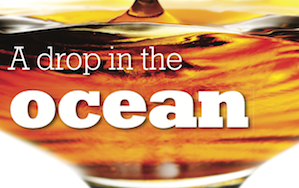Overreliance is too strong a word, but what happens in Asia matters, especially China (third largest market by volume and value) and its gateway markets of Singapore (second by both measures) and Hong Kong (sixth and fifth respectively).
Allocation of old, in-demand stocks is now the name of the game. At Frapin, China makes up the same portion of sales as the whole of Europe. “We allocate stocks to China carefully, therefore our agents limit sales mainly to the south, Canton province,” says Philippe Manfredini, directeur international at Frapin. “We don’t want to put all our eggs in one basket and want to maintain our sales in other parts of Asia.”
Courvoisier is more renowned for its dealings in the US and UK, but has announced a shift in focus. “Asia is the biggest region and China [including shipments through Singapore and Hong Kong] is the biggest market. That brings about challenges as we need to make sure we can get hold of high-end liquids, which are going through the roof. It’s good from a balance sheet standpoint, but not so good from a liquid standpoint.” Compared to the likes of Pernod’s Martell with its vast distribution, Courvoisier is really only just getting started in Asia. Even now, with the Chinese boom long detonated, 69% of its juice still ends up elsewhere in its VS-shaped bottles.
Most of the big houses will not talk of a strain on supply. Asked if it is frustrating to see VSOP-and-above stocks set aside for Asia, not the UK, Moët Hennessy UK responds: “As the number one Cognac in the world we look at the brand from a global perspective.” Read of that what you will.
At Rémy Martin double-digit organic growth has been achieved for the fourth consecutive year, an increase of 12.7%. The group’s policy of “moving upmarket” and dealing in “modest volume increases” must be doing the trick and on the surface seems to align the brand with Asia. The key drivers of growth have been attributed to the broad regions of the Americas and Asia, so it’s impossible to know exactly where the catalyst markets really lie.
The brand’s Lecarpentier is certainly keen to quell talk about being China-centric. “At Rémy Martin we are a global brand and we have many customers around the world. We continue to invest in Europe, which along with Africa and the Middle East is 20%-25% of our [value] sales. The Americas is 26.8%. Demand is big so we try to allocate correctly – we do not give all the Cognac to China.” That said, Lecarpentier says 60.2% of revenues are from Asia, a good chunk of which is down to China.
Perhaps not bound by big-brand pressures, H Mounier, producer of Prince Hubert de Polignac, has a different view. “The speed of access to Cognac in Asia is challenging. If you measure the number of Chinese able to drink more than a glass of Cognac in the 10 years to come, it is frightening,” says Christophe Juarez, the company’s président du directoire. “The globalisation is affecting the scale of our operations at full speed and it is a major issue for old industries like ours. Viticulture is our limit. It will take time to do it the right way. I understand this is a hard message for our Chinese customers, given their 8% GDP growth and their high demand: they have waited so long to have access to our products.”




